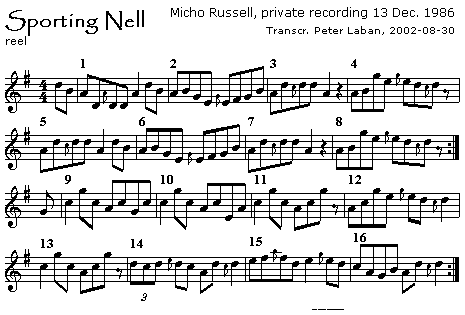A brief analysis by Peter Laban, 30 August 2002

Late in 1986 Micho went on a tour of continental Europe. I had the honour to be asked to play some concerts together with him. The tune presented here was taken from a recording I made at one of the concerts, on 13 December 1986.
Sporting Nell is a well-known reel. Two fairly distinct versions are in circulation; one of these, the one Micho plays here, is strongly associated with the concertina playing of County Clare especially with that of Elisabeth Crotty of Kilrush.
Micho and his brothers learned a lot of their music from their neighbour, concertina player Patrick Flanagan of Doonagore, Doolin. Micho was strongly influenced by Flanagan and other concertina players, indeed it is often said he tried to reproduce the concertina music he grew up with on the whistle. In many of Micho's older tunes, he moves with a remarkable freedom through the octaves, raising or dropping notes a full octave in places. His approach to Sporting Nelly, as he called it, is a good example of this. The older style of concertina playing, played on the old two row "German" concertinas, made an extensive use of doubling notes in octaves to achieve a fuller sound. The playing of the late John Kelly, Mrs Crotty, Micho Doyle of Spanish Point, the wonderful music of Mary Haren and Micho's own brother Packie are examples of this style. It can also be found very strongly in the playing of Kitty Hayes of Miltown Malbay who, after being away from the concertina for 45 years has taken up the instrument, retaining the style she learned to play over 50 years ago.
Micho's jumping through the octaves cannot be fully explained by practical considerations (eg raising a bottom D to the stronger high d'): it may well be something he picked up playing along with the German concertinas, following the octave that stood out most in the doubled notes. Micho used an E-flat whistle and flute for his solo part of the concert, but I have written the tune as if the bottom note was a D, as is the common practice.
Bars 1 and 2 The start of the tune is pretty much in a standard fashion, note how Micho approaches the ADDD figure, cutting the second D.
Bars 3 and 4 introduce a strong example of how Micho jumps through the octaves the low Ds are gone and replaced by high ones and the end of the first half of the part is raised as well, which adds greatly to the general jumpy atmosphere of the tune. The approach to the second half of the first part is very similar. It is worth noting Micho's frequent ornamentation of the high d: no crans are used, he simply cuts the d with the middle finger of the left hand (top hole open for high d) or cuts with the lower finger of the right hand. He manages to do this with a variety of rhtyhmic shades, varying from a simple cut right up to making the figure sound liek a full blown triplet.
Bars 9 to 13 see in a way the process reversed as a couple of high as and gs you may expect to find are dropped into the lower octave.
Bar 14 sees a bit of variation with a nice little figure on the ds. Bar 15 has a little twist in the tail of the tune where concertina and fiddle players go for an f natural, Micho uses what you might call a rising roll sort of figure, slightly flattening the f in the process. Bar 16 sees the conclusion of the tune, apparently going for the low ending in the first half of the bar but opting for the high d instead.
Please note, as usual, the transcription was done with an imperfect ear. It won't be faultless but it was what I heard when writing it.
Peter Laban, 30 August 2002